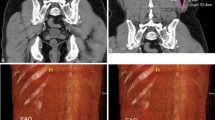Abstract
Purpose
To improve the knowledge of the morphometry and the surrounding anatomical structures of the intersigmoid fossa and to determine possible surgical applications.
Method
Forty eight adult cadavers (29 female and 19 male; mean age 83 years) underwent dissection in the Laboratoire d’Anatomie des Alpes Francaises. Two injections in the right carotid resulted in a total body concentration of formalin of 1.3 %. The study parameters were the dimensions of the intersigmoid fossa orifice and the fossa’s relationship to surrounding structures. Data were recorded and analyzed using Microsoft Office Excel (MS Cerp). A Pearson coefficient r was used to examine the correlation between the length of colon and the ISF volume.
Results
The intersigmoid fossa was present in 75 % of cases (n = 36). The average dimensions for the transverse diameter, longitudinal diameter, and the depth were, respectively, 20.5 ± 0.2, 20.3 ± 0.13, and 26.8 ± 0.2 mm. The primary and secondary roots bordering this fossa measured on average 59.1 ± 0.1 and 48.3 ± 0.13 mm. In 13.9 % of cases (n = 5), the maximum depth was >40 mm and in 16.7 % of cases (n = 6), one of the diameters of the orifice entry of the fossa was >40 mm. The ureter and external iliac artery were the most frequently encountered structures during the dissection of the fundus of the intersigmoid fossa.
Conclusion
The intersigmoid fossa remains present in most of the reported dissections of cadavers. It constitutes an essential landmark in the surgery of the sigmoid colon due to its deep structural relationship with the left ureter and external iliac artery.





Similar content being viewed by others
References
Armstrong O, Hamel A, Hamel O, Rogez JM, Robert R, Leborgne J et al (2005) Hernies internes: anatomie chirurgicale. Morphologie 89:195
Berthet B, Assadourian R (1993) A rare form of internal hernia: hernia of the sigmoid mesocolon. J Chir 130:170–172
Bouchet A, Cuilleret J (1991) Anatomie topographique, descriptive et fonctionnelle, tome4: L’abdomen, la région rétro-péritonéale, le petit bassin, le périnée 2e edn. Masson, Paris
Delmas A, Rouvière H (2002) Anatomie humaine descriptive, topographique et fonctionnelle Tome 2, Tronc, 15e ed. Masson
Edward M, Livingstone B (1933) A clinical study of the abdominal cavity and peritoneum. Br J Surg 20:540
Godlewski G (1994) Le colon. In: Chevrel JP Anatomie clinique Le Tronc. Springer. pp 359–61
Harrison OJ, Sharma RD, Niayesh MH (2011) Early intervention in intersigmoid hernia may prevent bowel resection—A case report. Int J Surg Case Rep 2:282–284
Jorge JMN, Habr-Gama A (2007) Anatomy and embryology of the colon, rectum, and anus. In: Wolff BG, Fleshman JW, Beck DE, Pemberton JH, Wexner SD, Church JM et al (eds) Colon and rectal surgery. Springer, New York, pp 1–22
Kamina P, Gouazé A (2014) Anatomie clinique Tome 3, Thorax, Abdomen, vol 4. Maloine, Paris
Kotobi H, Echaieb A, Gallot D (2005) Traitement chirurgical des hernies rares. EMC Chir 2:425–439
Lapeyre A (1906) Contribution à l’étude de la pathologie et de la chirurgie du colon pelvien. La Gazette médicale du Centre, pp 179–189
Madiba TE, Haffajee MR (2010) Anatomical variations in the level of origin of the sigmoid colon from the descending colon and the attachment of the sigmoid mesocolon. Clin Anat 23:179–185
Martin LC, Merkle EM, Thompson WM (2006) Review of internal hernias: radiographic and clinical findings. Am J Roentgenol 186:703–717
Nihon-Yanagi Y, Ooshiro M, Osamura A, Takagi R, Moriyama A, Urita T et al (2010) Intersigmoid hernia: report of a case. Surg Today 40:171–175
Olusegun IA, Olusegun O, Polycarp N, Ganiyat OE, Abidemi O (2013) The role of anatomy of the sigmoïd colon in developing sigmoid volvus: a cross sectional study. Surg Radiol Anat 35:249–257
Pérignon L (1892) Etude sur le développement du péritoine dans ses rapports avec l’évolution du tube digestif et de ses annexes. Steinheil, Paris
Poirier P, Charpy A (1901) Traité d’anatomie humaine, tome 5. Masson et Cie, Paris
Testut L, Jacob O (1906) Traité d’anatomie topographique avec applications médico-chirurgicales Tome second (1er fascicule) Abdomen et bassin. Octave Doin, Paris, pp 248–250
Thomas J (2010) Anatomie Topographique du duodénum et hernies duodénales. Nabu Press, Charleston
Thomson FB, Robins RE (1953) Intersigmoid hernia—case report. Ann Surg 138:917–918
Watanabe T, Wada H, Sato M, Miyaki Y, Shiiya N (2014) Single-incision laparoscopic surgery for intersigmoid hernia. Case Rep Surg 2014. doi:10.1155/2014/589649
Author information
Authors and Affiliations
Corresponding author
Ethics declarations
Conflicts of interest
The authors declare that they have no conflict of interest.
Rights and permissions
About this article
Cite this article
Somé, O.R., Ndoye, J.M., Yohann, R. et al. An anatomical study of the intersigmoid fossa and applications for internal hernia surgery. Surg Radiol Anat 39, 243–248 (2017). https://doi.org/10.1007/s00276-016-1747-1
Received:
Accepted:
Published:
Issue Date:
DOI: https://doi.org/10.1007/s00276-016-1747-1




